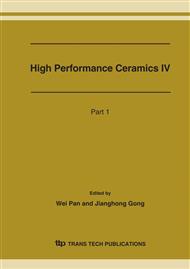p.1872
p.1874
p.1878
p.1882
p.1886
p.1889
p.1892
p.1895
p.1898
Activated Alumina Adsorbent Developed from Waste Aluminum Sludge
Abstract:
Alumina adsorbent was synthesized from waste aluminum sludge in this research. The nitrogen isothermal adsorption method (77K) is applied to measure the BET specific surface area and pore structure of activated alumina at different activation temperatures. The research results indicate that, thermal treatment has huge influences on the test sample’s specific surface area and pore structure. Its specific surface area and pore volume expand and then diminish, whereas the holding time rises, getting its peak of 348 m² /g and 0.55 (cm³ /g) respectively at the activation temperature of 600°C and holding time for 1 hour. The average pore diameter value increases along with the lengthening of activation temperature and holding time, reaching the maximum of 11nm at activation temperature of 750°C and holding time for 4 hours. After comprehensive analysis, the activation temperature of 600°C and holding time for 1 hour are determined as ideal conditions for activated alumina respectively.
Info:
Periodical:
Pages:
1886-1888
Citation:
Online since:
April 2007
Authors:
Price:
Сopyright:
© 2007 Trans Tech Publications Ltd. All Rights Reserved
Share:
Citation:


